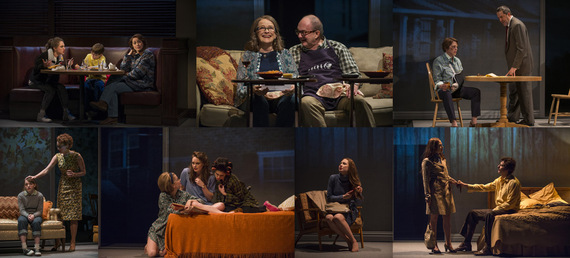All storytelling involves omission. What do you leave out when you tell a story? Last September in The New Yorker, John McPhee explained how he has wrestled with this challenge in his writing. "Writing is selection," he observed in a delightful essay titled "Omission." McPhee went on to quote a famous comment by Ernest Hemingway: "If a writer of prose knows enough about what he is writing about he may omit things that he knows and the reader, if the writer is writing truly enough, will have a feeling of those things as strongly as though the writer had stated them. The dignity of movement of an iceberg is due to only one-eighth of it being above water."
The new play by Tracy Letts, Mary Page Marlowe, presents a narrative where the omissions are especially noticeable. We see the title character at various stages of her life, portrayed by six different actresses, with the scenes scrambled out of chronological sequence. The effect reminded me of what it's like if you occasionally run into an acquaintance over the decades. When you see that person after a gap of several years, you notice how different her or she seems, and you may wonder what has happened in his or her life since your previous encounter. That gap is likely to remain a mystery to you.
Gaps in a fictional narrative such as Letts' play (now in its world premiere at Steppenwolf Theatre, deftly directed by Steppenwolf's artistic director, Anna D. Shapiro) are mysterious, too--blank pages left for us to fill in with our imagination. In some narrative works, such omissions are frustrating. We feel cheated that key moments in a story have been withheld from us. That's apparently how Chicago Reader critic Tony Adler felt about Mary Page Marlowe:
Letts perversely denies us the chance to share in what should be the most fascinating passages in the play--that is, in the play that hangs like a hungry spirit over this one, waiting to be written.
Chicago Sun-Times critic Hedy Weiss also gave the play lukewarm praise:
Each scene is superbly written, but the pieces are more satisfying than the whole.
I understand why Letts' drama might elicit those responses, but the unseen gaps in Mary Page Marlowe's life felt to me more like a fascinating puzzle. What exactly happened to this woman in the missing months and years in between the scenes we witness? How did her decisions--and the actions of those around her--transform her from one stage of her life to the next? We learn the basic outlines, but Letts and the stellar cast in Steppenwolf's production don't offer any simple explanations. We learn just enough that this woman's transformations are plausible.
It was a shrewd decision to use six actresses to play Mary Page Marlowe (Blair Brown, Carrie Coon, Laura T. Fisher, Caroline Heffernan, Annie Munch and Rebecca Spence). They look similar enough that it's plausible they're all the same character, but we're obviously aware of the fact these are different actresses. It puts an emphasis on how much this woman changes over time. Each actress makes the most of her limited time onstage, creating indelible moments. (But as Time Out Chicago's review points out, the need for six performers in the title role plus another 13 cast members could make this a challenging play for other theaters to stage in the future -- it's a big undertaking.)
Chicago Tribune critic Chris Jones gave high praise to Mary Page Marlowe, stressing the play's theme of how choices change the course of our lives:
For any life, remarkable or otherwise, is made up only partly of the choices, often the lousy choices, that we make for ourselves. It also is a construction of the choices that others make on our behalf, especially when we are very young, and from which extrication can prove difficult, if not impossible.
But Jones did fault the ending -- a final scene that seemed to leave the audience puzzled at the performance I attended, perhaps wondering for a few seconds: Is it over? But New York Times critic Charles Isherwood led off his glowing review with a quote from that last scene:
"It's pretty fragile." Those words, spoken by the title character in "Mary Page Marlowe," the exquisite new play by Tracy Letts having its premiere at the Steppenwolf Theater here, refer to a quilt in need of some delicate dry cleaning. But they resonate with many meanings in Mr. Letts's haunting, elliptical drama about the evolutions, reversals and resurrections in a woman's life. A quilt is a clever symbol for the unusual structure of the play itself.
As Isherwood astutely observes, Mary Page Marlowe resembles a quilt. As we look at this patchwork, we're left to imagine what we're not seeing. What we do see is memorable and moving.
Mary Page Marlowe continues through June 5 at Steppenwolf Theatre.
Photos by Michael Brosilow, Steppenwolf Theatre. Photos in top row, from left to right: Madeline Weinstein as Wendy Gilbert, Jack Edwards as Louis Gilbert and Rebecca Spence as Mary Page Marlowe; Blair Brown as Mary Page Marlowe and ensemble member Alan Wilder as Andy; Laura T. Fisher as Mary Page Marlowe and Ian Barford as Ray. Photos in bottom row: Caroline Heffernan as Mary Page Marlowe and Amanda Drinkall as Roberta Marlowe; Tess Frazer as Lorna, Annie Munch as Mary Page Marlowe and Ariana Venturi as Connie; Carrie Coon as Mary Page Marlowe; Coon and Gary Wilmes as Dan.

